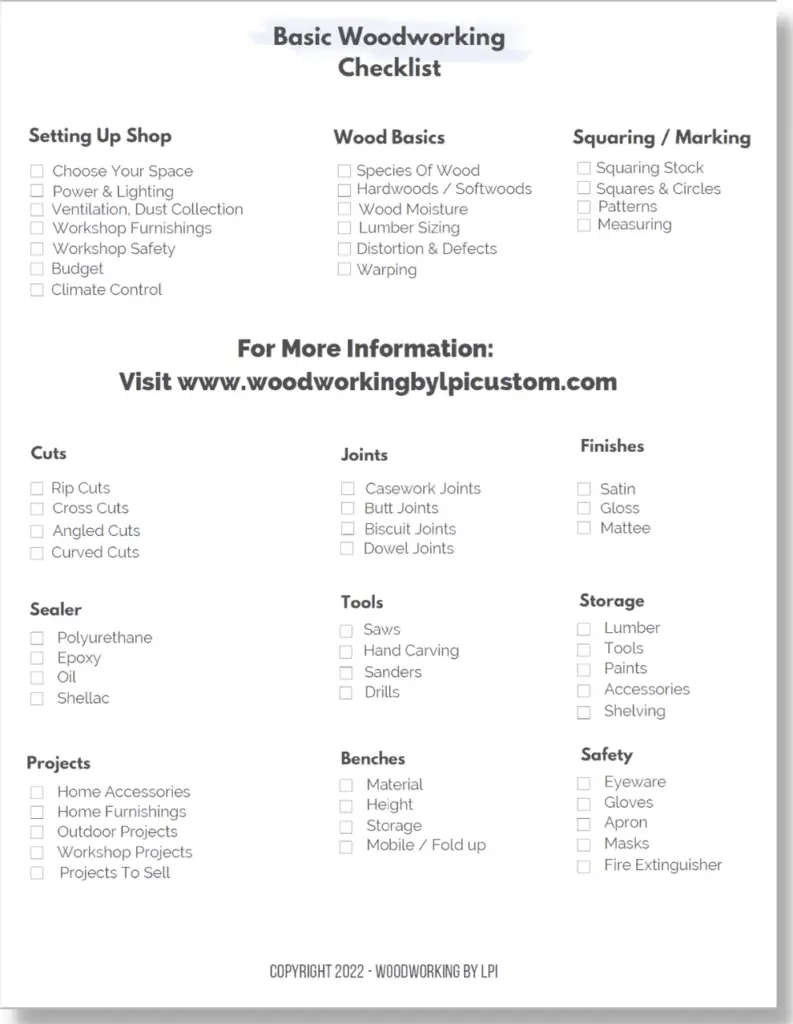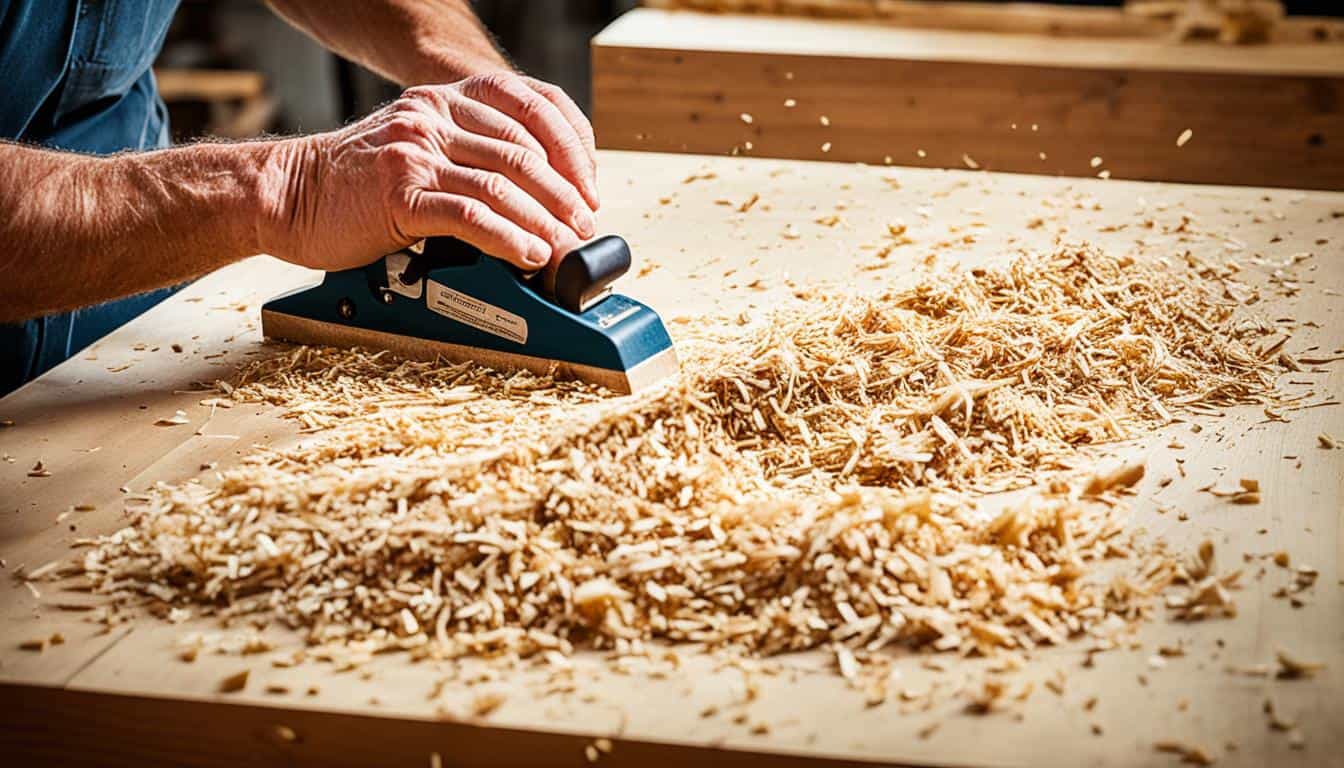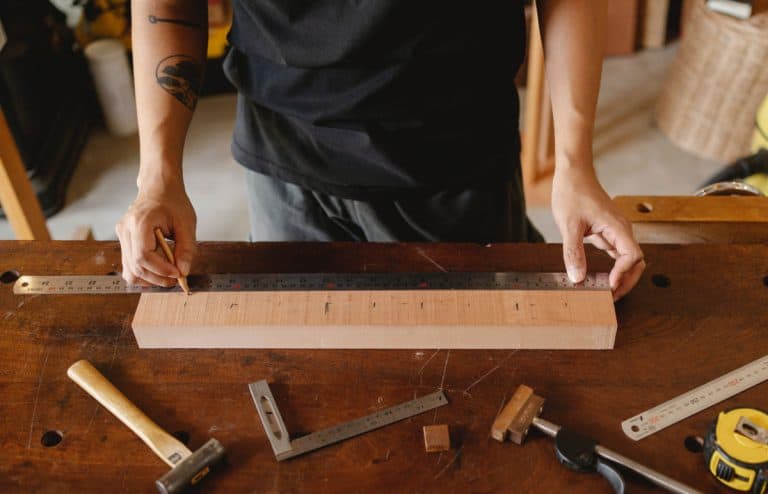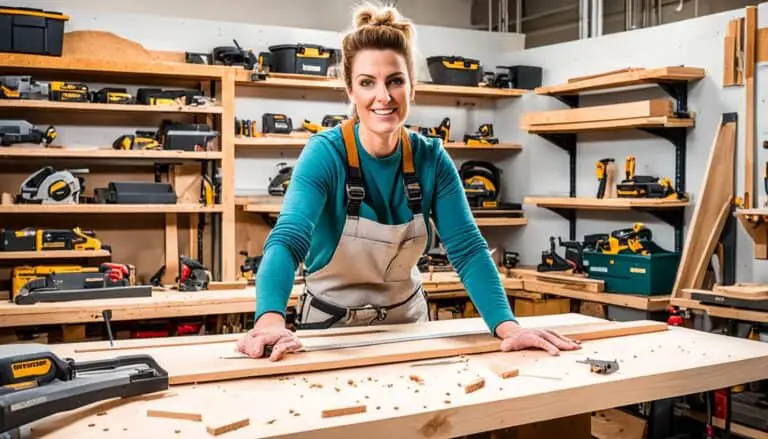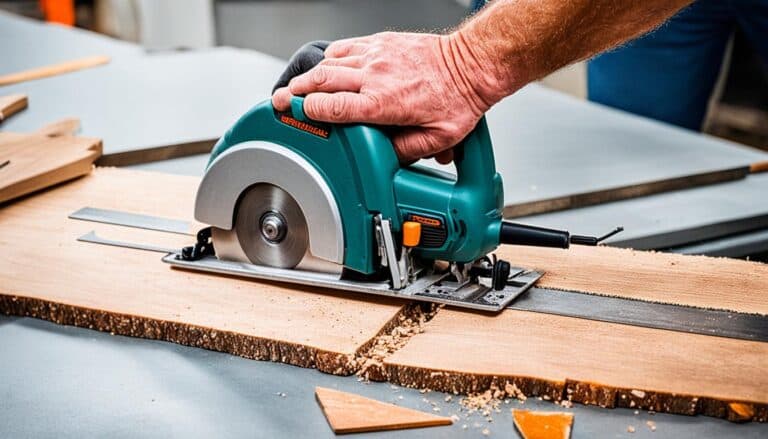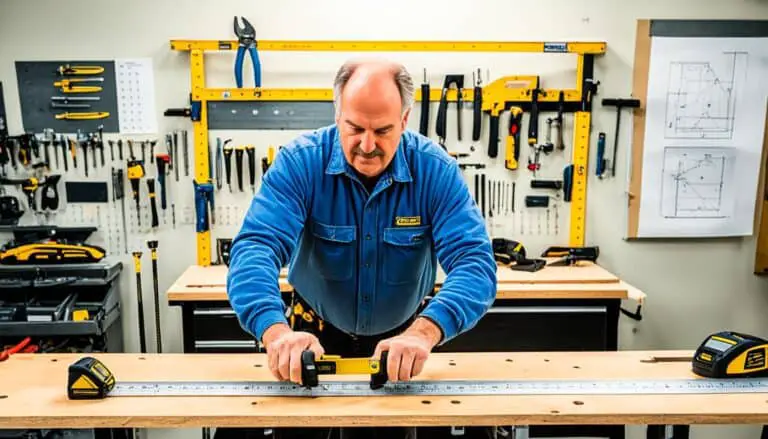Welcome to our essential guide on choosing hand planes for your woodworking projects. Hand planes play a crucial role in woodworking, allowing you to flatten, smooth, and shape boards with precision and control. Whether you’re a beginner or an experienced woodworker, understanding the different types of hand planes and how to choose the right ones for your needs is essential.
Key Takeaways:
- Hand planes are indispensable tools for woodworking, enabling you to flatten, smooth, and shape boards.
- They come in various shapes, sizes, and materials, and choosing the right ones can be confusing for beginners.
- Hand planes can be categorized into bench planes, joinery planes, and molding planes.
- When buying hand planes, consider the specific woodworking tasks you’ll be doing and select the appropriate planes for those needs.
- Proper maintenance, including sharpening the blades and regular adjustments, is crucial for optimal performance.
What is a Handplane?
A hand plane is an indispensable tool in traditional woodworking, used for flattening, smoothing, and shaping boards. It consists of a sharp chisel securely held at an angle in a body made of wood or metal. Hand planes are commonly used in furniture making to achieve smooth and precise results. With their versatility and craftsmanship, hand planes have stood the test of time as essential woodworking hand tools.
The Anatomy of a Hand Plane
A hand plane typically consists of the following components:
- Blade: The sharp chisel responsible for cutting and shaping the wood.
- Cap Iron: Also known as the chip breaker, it helps control the shaving and prevent tear-outs.
- Frog: The part that holds the blade assembly and allows for adjustments.
- Lever Cap: Secures the blade assembly in place.
- Handle: Provides a comfortable grip and control over the plane.
- Knob: Located at the front of the plane, it aids in maneuvering and guiding the hand plane.
- Sole: The flat and smooth bottom surface that contacts the wood.
Types of Hand Planes
Hand planes come in various shapes, sizes, and materials, each designed for specific tasks. Here are some of the common types of hand planes:
- Block Plane: Small and versatile, ideal for trimming and planing end grain.
- Smoothing Plane: Used for final smoothing and refining of surfaces.
- Jack Plane: Suitable for removing excess material and initial dimensioning.
- Jointer Plane: Designed for flattening and straightening long edges.
- Router Plane: Used for creating precise grooves and dadoes.
- Shoulder Plane: Specifically made for cleaning up and fine-tuning shoulder cuts.
Choosing the Right Hand Planes
Choosing the right hand planes can be overwhelming, especially for beginners. Consider the woodworking tasks you will be undertaking and the type of wood you will work with. Start with a versatile block plane and gradually expand your collection based on your specific needs. Investing in high-quality hand planes from reputable brands ensures durability and superior performance.
“A well-crafted hand plane is an extension of your woodworking skills, allowing you to shape wood with precision and finesse.”
Different Types of Hand Planes
When it comes to woodworking, hand planes are an indispensable tool. They allow you to shape, flatten, and smooth boards with precision and control. Hand planes come in various types, each designed for specific tasks. Understanding the different types of hand planes can help you choose the right tools for your woodworking projects.
Bench Planes
Bench planes are the workhorses of hand planes. They are used for flattening, dimensioning, and smoothing wood. Bench planes are typically used on larger surfaces and are available in different sizes to accommodate different woodworking needs. Whether you need to remove rough stock or achieve a smooth finish, bench planes are essential for any woodworking workshop.
Joinery Planes
Joinery planes are specialty planes used for creating or finishing joints. They are designed to produce precise and accurate results when working on joinery projects like dovetails, mortise and tenons, and rabbets. Joinery planes come in various forms, including rabbet planes, shoulder planes, and tongue & groove planes. These planes are crucial for achieving tight-fitting and sturdy joints.
Molding Planes
Molding planes, also known as moulding planes, are used for cutting decorative profiles on a board. They add intricate details and embellishments to your woodworking projects. Molding planes come in a wide range of profiles, allowing you to create various designs such as coves, beads, ogees, and many more. These planes are essential for adding a touch of elegance and craftsmanship to your work.
To better understand the differences between bench planes, joinery planes, and molding planes, refer to the table below:
| Hand Plane Type | Primary Use |
|---|---|
| Bench Planes | Flattening, dimensioning, and smoothing wood |
| Joinery Planes | Creating or finishing joints |
| Molding Planes | Cutting decorative profiles on a board |
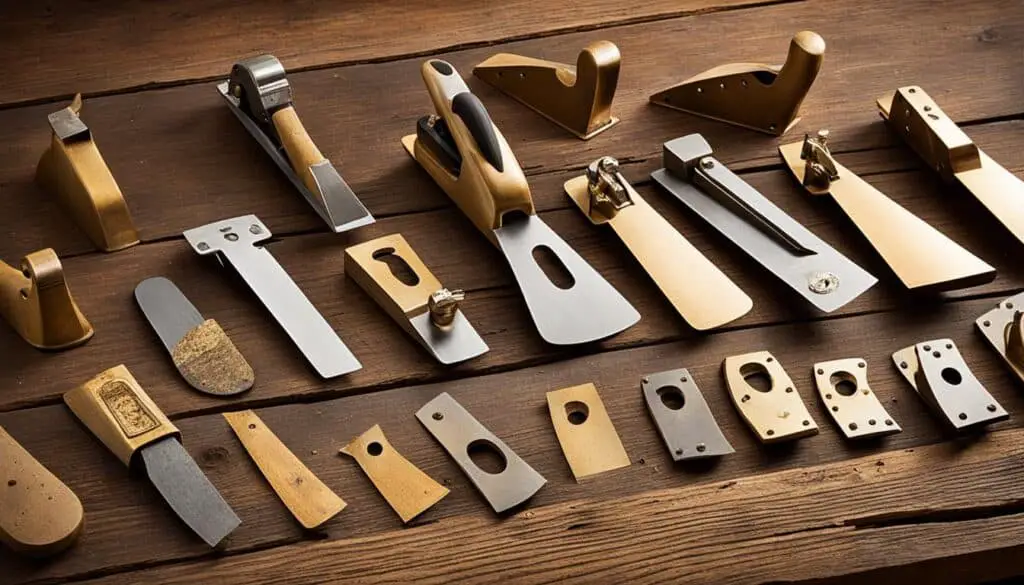
By understanding the different types of hand planes and their specific uses, you can select the right tools for your woodworking projects. Whether you’re working on a large-scale furniture piece or adding intricate details to a small box, having the right hand plane at your disposal will ensure precision, efficiency, and outstanding results.
Buying Bench Planes
Bench planes are an essential tool for woodworking, offering versatility in shaping, flattening, dimensioning, and smoothing boards. When it comes to buying bench planes, understanding the different styles and their specific purposes is crucial.
Types of Bench Planes
There are six common styles of bench planes:
- Jack Planes: Ideal for rough stock removal and evening out surfaces.
- Jointer Planes: Used for flattening long edges and leveling wide boards.
- Smoothing Planes: Perfect for fine finishing and achieving silky smooth surfaces.
- Block Planes: Compact planes suitable for small-scale work and end-grain planing.
- Scrub Planes: Designed to quickly remove material and flatten rough surfaces.
- Fore Planes: Similar to jack planes but longer, used for heavy stock removal.
Each style of bench plane serves a specific purpose in the woodworking process. By understanding their functions, you can select the appropriate bench planes to fulfill your woodworking needs.
Recommended Bench Planes
| Bench Plane Style | Recommended Brands |
|---|---|
| Jack Planes | Stanley, Lie-Nielsen, WoodRiver, Veritas |
| Jointer Planes | WoodRiver, Lie-Nielsen, Veritas |
| Smoothing Planes | Stanley, Lie-Nielsen, WoodRiver, Veritas |
| Block Planes | Stanley, Lie-Nielsen, WoodRiver, Veritas |
| Scrub Planes | Veritas, Lie-Nielsen, WoodRiver |
| Fore Planes | Veritas, WoodRiver, Lie-Nielsen |
These brands offer reliable and high-quality bench planes. Consider your budget, preferences, and user reviews when selecting a specific brand for each style of bench plane.
Remember, bench planes are long-term investments in your woodworking journey. Choose wisely based on the projects you plan to undertake and your personal preferences. Happy woodworking!
Buying Joinery Planes
Joinery planes are specialized hand planes that are essential for creating and finishing joints in woodworking projects. They are designed to cut precise and accurate joints, ensuring tight fits and strong connections. If you are considering buying joinery planes for your woodworking arsenal, it is crucial to understand the different types available and choose the right planes for your specific joints.
Rabbet Planes
Rabbet planes, also known as rebate planes, are used to cut rabbets, which are recesses or grooves cut along the edge or face of a board. These planes are commonly used to create strong connections between two boards, such as when making drawers or joining frames.
Plow Planes
Plow planes are versatile planes that are used to cut grooves or trenches in a board. They are often used to create grooves for inserting panels or creating decorative moldings. Plow planes can be set to cut grooves of different widths to accommodate various joinery needs.
Shoulder Planes
Shoulder planes are designed specifically for cutting and cleaning up shoulder joints. They have a narrow blade that extends to the edges of the plane’s body, allowing precise and controlled cuts on the shoulders of tenons and other joints. Shoulder planes are particularly useful for creating precise and clean-fitting joinery.
Tongue & Groove Planes
Tongue and groove planes are used to create interlocking tongues and grooves on boards. The tongue on one board fits neatly into the corresponding groove on another board, creating a secure and seamless joint. These planes are commonly used in flooring and paneling applications.
Router Planes
Router planes are specialized planes that are used to cut and clean up the bottoms of grooves, dados, and other recesses. They feature a blade that extends below the sole of the plane, allowing precise and controlled cuts in shallow or deep areas. Router planes are versatile tools that can be used for various joinery tasks.
When buying joinery planes, it is important to consider the specific joints you will be working on. Each type of joinery plane serves a specific purpose and is designed to cut a particular joint with precision. Consider the type and size of joints you will be making, as well as the materials you will be working with, to select the appropriate joinery planes for your woodworking projects.
Buying Molding Planes
Molding planes, also known as moulding planes, are essential tools for any woodworking enthusiast looking to create decorative profiles on boards. These specialized planes come in various types, including dedicated molding planes, hollows & rounds, snipe bills, and beading planes. When purchasing molding planes, it’s crucial to consider the specific molding profiles you’ll be working with to choose the appropriate planes for your designs.
Types of Molding Planes
Molding planes offer a range of capabilities for achieving different decorative profiles. Here are the main types of molding planes:
- Dedicated Molding Planes: These planes are designed to cut specific profiles and are typically marked with the intended profile shape.
- Hollows & Rounds: Hollows cut concave profiles, while rounds cut convex profiles. They are used in tandem to create complex molding designs.
- Snipe Bills: Snipe bills have a unique shape that allows them to cut deep channels and grooves for decorative applications.
- Beading Planes: Beading planes are used specifically for creating decorative bead profiles.
Considerations when Buying Molding Planes
When purchasing molding planes, keep the following factors in mind:
- Molding Profiles: Determine the specific types of molding profiles you’ll be creating. Different molding planes are designed for various shapes and sizes.
- Quality and Condition: Look for well-crafted planes made from high-quality materials. Consider buying vintage planes that have been well-maintained or opt for modern replicas.
- Compatibility: Ensure that the molding planes you choose are compatible with your existing tools and equipment.
- Price: Set a budget and compare prices from different sources to find the best value for your money.
By carefully selecting molding planes based on your specific needs, you can enhance the beauty and intricacy of your woodworking projects.
Bench Planes
Bench planes are the workhorses of hand planes and are indispensable for a wide range of woodworking tasks. Whether you’re shaping rough lumber, flattening surfaces, or achieving a smooth finish, bench planes are the go-to tools for the job. With their versatile functions and ability to remove material quickly and efficiently, bench planes are a must-have in any woodworker’s toolbox.
Types of Bench Planes:
There are four main types of bench planes that serve different purposes:
- Jointer planes: Designed for flattening large surfaces, jointer planes are longer and wider than other bench planes. They are perfect for achieving flat edges and surfaces on boards, especially when jointing multiple pieces together.
- Jack planes: Jack planes are the workhorses of woodworking. They are versatile, intermediate-sized planes that excel at removing material quickly and leveling rough surfaces.
- Smoothing planes: Smoothing planes are smaller than jack planes and are used for refined smoothing of surfaces. They are great for achieving a glass-like finish and removing any imperfections left by other planes.
- Block planes: Block planes are compact, handheld planes that offer excellent maneuverability. They are ideal for smaller-scale tasks, such as chamfering edges, trimming end grain, and fitting joints.
Each type of bench plane is designed to excel in specific woodworking tasks, from initial rough shaping to final surface finishing. By having a set of bench planes, you’ll have the versatility and precision needed to tackle various woodworking projects.
Tips for Using Bench Planes:
When using bench planes, keep the following tips in mind:
- Start with a sharp blade: Sharp blades ensure clean and precise cuts. Regularly sharpen and hone the blades to maintain optimal performance.
- Adjust the plane properly: Each type of bench plane has specific adjustment mechanisms. Learn how to adjust the depth of cut, lateral position, and throat opening to achieve the desired results.
- Use the right technique: Mastering proper hand placement and using controlled, even strokes will yield better results and minimize the risk of accidents.
- Work with the grain: Planing with the grain reduces tear-out and produces smoother surfaces. Pay attention to the direction of the wood grain and adjust your planing technique accordingly.
- Maintain your planes: Keep your bench planes clean and free from debris. Regularly lubricate the adjustment mechanisms to ensure smooth operation.
By understanding the different types of bench planes and how to use them effectively, you’ll be well-equipped to tackle any woodworking project with confidence and precision.
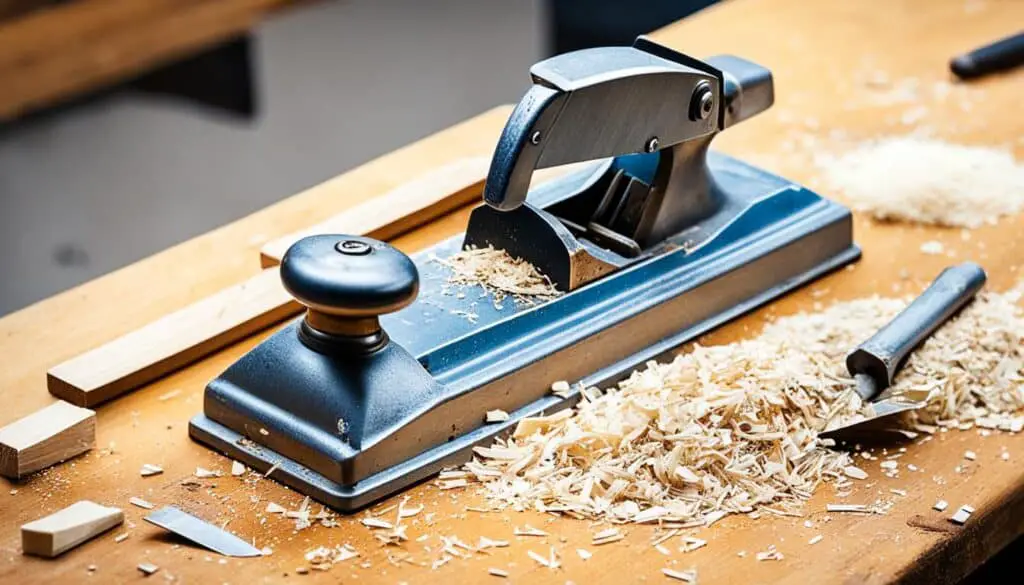
Block Planes
If you’re looking for a versatile tool that excels at trimming small areas and planing end grain, block planes are a great choice. These small and compact hand planes are designed to provide precision and control in tight spaces. With their unique features and functionality, block planes are essential for detail work and shaping the end grain of boards.
Types of Block Planes
Block planes come in two main varieties: standard block planes and low-angle block planes. Each type has its own distinct characteristics that make them suitable for specific woodworking tasks.
1. Standard Block Planes
Standard block planes are the most common type and are valued for their versatility. They feature a blade pitched at an angle of 20 degrees, which allows them to perform a wide range of tasks. The steep angle of the blade makes it effective for planing end grain and smoothing surfaces.
2. Low-Angle Block Planes
Low-angle block planes are ideal for finer and more delicate woodworking tasks. They have a blade pitched at a lower angle of 12 degrees, which makes them exceptionally effective for end grain work and cutting across the wood’s grain. Low-angle block planes are renowned for their ability to create precise, smooth, and clean cuts.
By having both standard block planes and low-angle block planes in your toolbox, you can tackle various woodworking projects with ease, whether it’s trimming, shaping, or smoothing.
“Block planes are must-have tools for any woodworker, offering excellent control and precision in intricate woodworking tasks.”
Adding an image of block planes will not only enhance the visual appeal of this section but also provide a clear representation of these tools and their form-factor.
Plane Alternatives
While hand planes are traditionally used for woodworking, there are alternative tools available for shaping and smoothing different materials. These alternatives offer specialized features for specific tasks, providing efficiency and convenience in various applications.
Replaceable-Blade Planes
If you primarily work with plywood and particleboard, replaceable-blade planes can be an excellent alternative to traditional hand planes. These planes feature disposable blades that can be easily replaced when they become worn or dull. This eliminates the need for sharpening and ensures consistent cutting performance.
Replaceable-blade planes are designed to handle the unique properties of engineered wood, making them ideal for creating smooth surfaces and precise edges. They are also popular among professionals who require quick blade changes for increased productivity.
Surface-Forming Planes
For shaping materials such as drywall, PVC, or plastic laminates, surface-forming planes are the go-to alternative to hand planes. These planes have a specialized blade that files away material, allowing you to sculpt and contour surfaces with ease.
The unique design of surface-forming planes enables efficient material removal, making them suitable for tasks like trimming, beveling, and creating curved profiles. Whether you’re working on architectural installations or DIY projects, surface-forming planes offer versatility and precision for achieving the desired results.
When selecting plane alternatives, consider the specific materials and tasks you will be working with. Assess the features and capabilities of each alternative to find the most suitable tool for your woodworking needs.
To further understand the benefits of replaceable-blade planes and surface-forming planes, here’s a comparison table:
| Replaceable-Blade Planes | Surface-Forming Planes |
|---|---|
| Designed for plywood and particleboard | Efficient material removal |
| Disposable blades for easy replacement | Perfect for shaping drywall, PVC, or plastic laminates |
| Consistent cutting performance | Ability to sculpt and contour surfaces |
As you can see, both replaceable-blade planes and surface-forming planes offer unique advantages that can enhance your woodworking experience. Choose the alternative that best suits your specific materials and requirements to achieve exceptional results.
Sharpening the Blade
To ensure optimal performance, it is crucial to sharpen your hand plane blades properly. Sharpening not only enhances the cutting ability but also extends the lifespan of the blade. The process involves using a sharpening stone or sandpaper to achieve a razor-sharp edge.
Here are the steps to sharpening hand plane blades:
- Start by securing the blade firmly. Use a honing guide or clamp the blade to prevent it from moving during sharpening.
- Select a sharpening stone or sandpaper with a medium grit, around 1000 to 1500. Begin the sharpening process by eliminating any visible nicks or imperfections on the blade. Maintain a consistent angle of 25-30 degrees while guiding the blade across the sharpening surface. Repeat this step until the blade is clean and sharp.
- Next, switch to a finer stone or sandpaper with a grit of 4000 to 8000. This step helps refine the edge, removing any burrs or irregularities caused by the previous sharpening. Again, maintain the same angle and stroke the blade across the surface until it achieves a polished and razor-sharp edge.
Blade maintenance is equally important to ensure clean and precise results. After each use, inspect the blade for any signs of dullness or damage. If necessary, perform touch-up sharpening to maintain the sharpness.
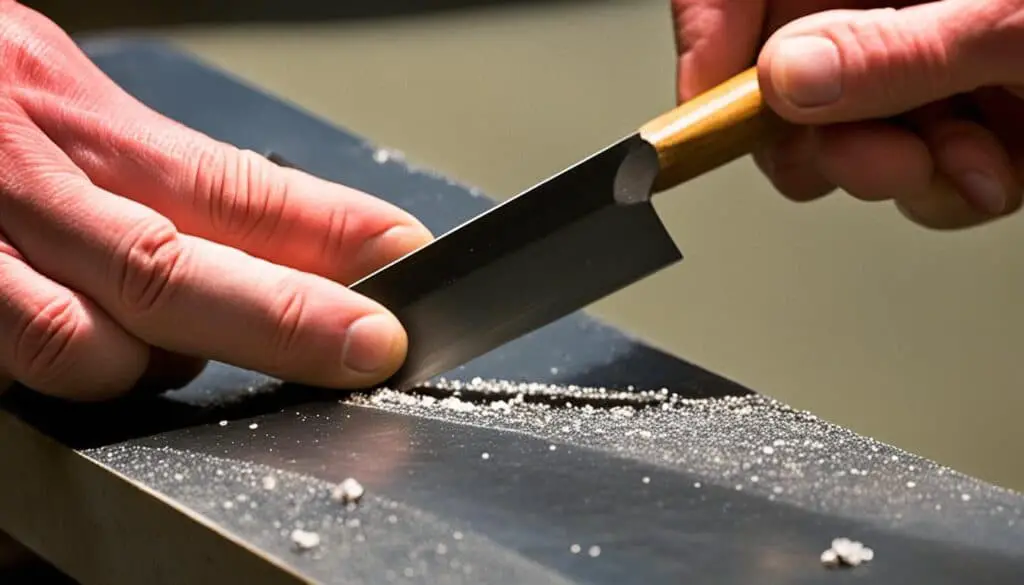
Mastering the art of sharpening hand plane blades can greatly enhance your woodworking experience. With a sharp blade, you’ll achieve smoother cuts and more precise results, making your hand plane a joy to work with.
Adjusting the Plane
Properly adjusting a hand plane is crucial for achieving accurate and smooth woodworking results. By understanding how to adjust the cutting depth and position the cutting edge, you can optimize the performance of your hand plane.
Adjusting the Cutting Depth
The cutting depth of a hand plane determines how much material is removed with each pass. To adjust the cutting depth, locate the depth adjustment wheel on the plane body. By turning the wheel clockwise, you can increase the cutting depth, and by turning it counterclockwise, you can decrease it. It’s important to make incremental adjustments and test the plane on scrap wood until you achieve the desired depth.
Positioning the Cutting Edge
The lateral adjustment lever on a hand plane allows you to position the cutting edge parallel to the mouth. This ensures even and consistent planing. To adjust the lateral position, loosen the lever slightly and tap the plane gently until the cutting edge aligns parallel to the mouth. Then, tighten the lever to secure the position.
Keep in mind that different types of hand planes may have additional adjustments to consider. For example, block planes often have a mouth width adjustment knob that allows you to control the size of the mouth opening. This adjustment affects the type of cut and the smoothness of the plane’s performance.
Regularly adjusting your hand plane according to the cutting depth and lateral position ensures optimal performance and more precise woodworking results. Take the time to familiarize yourself with the adjustment mechanisms of your specific hand plane and make adjustments as needed during your woodworking projects.
Safety Considerations
When using hand planes, the safety of yourself and those around you should always be a top priority. By following proper safety procedures and using the appropriate protective gear, you can minimize the risk of accidents and injuries.
Protective Gear
Always wear the necessary protective gear when working with hand planes. This includes safety goggles and gloves, which can protect your eyes from flying debris and your hands from potential cuts or nicks.
Proper Techniques
Using hand planes requires specific techniques to ensure safe and effective operation. Familiarize yourself with these techniques and follow guidelines to avoid accidents. Keep your fingers and hands clear of the cutting edge to prevent injuries and maintain control over the plane at all times.
“Safety first: Always follow proper techniques and guidelines when using hand planes.”
Maintaining Sharp Blades
Keeping your hand plane blades sharp is not only essential for achieving smooth results but also for safety. A sharp blade reduces the risk of tool slippage, which can lead to accidents. Regularly inspect your blade’s sharpness and sharpen it as needed to maintain optimal performance.
Manufacturer’s Instructions
It is crucial to read and follow the manufacturer’s instructions for safe use of your hand planes. Each tool may have specific safety considerations and operating procedures that you need to be aware of. Understanding these instructions will help you use the hand planes safely and efficiently.
Take a look at the image below to see the proper use of hand plane safety gear:
By following these safety considerations when using hand planes, you can create a safer and more enjoyable woodworking experience.
Recommended Hand Plane Brands
When it comes to choosing hand planes for your woodworking projects, it is important to select from reputable and reliable brands. Here are three highly recommended hand plane brands known for their quality and precision:
- Stanley: With a rich history dating back to 1843, Stanley is one of the most well-known and respected hand plane brands in the industry. They offer a wide range of hand planes, including bench planes, block planes, and specialty planes. Stanley hand planes are known for their durability, craftsmanship, and consistent performance.
- Veritas: Veritas is a brand that is synonymous with innovation and excellence in woodworking tools. Their hand planes are meticulously designed and engineered to meet the needs of both beginner and professional woodworkers. Veritas hand planes offer enhanced control, precision adjustments, and ergonomic features to ensure optimal comfort and performance.
- Irwin Tools: Irwin Tools is a trusted name in the woodworking industry, offering a diverse range of hand planes suitable for various applications. Irwin Tools hand planes are known for their affordability without compromising on quality. They are designed to deliver reliable performance and excellent value for money.
When choosing a hand plane brand, it is essential to consider your specific woodworking needs, budget, and preferences. Researching and reading reviews can provide valuable insights into the performance and reputation of different hand plane models offered by these brands.
Remember to select hand planes that align with your woodworking projects and skill level. With the right hand plane brand, you can achieve precision, smoothness, and efficiency in your woodworking endeavors.
Conclusion
Hand planes are essential woodworking hand tools that play a crucial role in shaping, smoothing, and flattening boards. Understanding the different types of hand planes available and their specific purposes empowers you to make well-informed decisions when choosing the best hand planes for your woodworking projects.
When selecting hand planes, consider your specific needs and the type of woodworking tasks you frequently undertake. Whether it’s bench planes for general shaping and smoothing, joinery planes for creating or finishing joints, or molding planes for cutting decorative profiles, there is a hand plane designed to suit your requirements.
Remember to prioritize safety when working with hand planes. Always wear appropriate protective gear, such as safety goggles and gloves, to safeguard yourself from potential injuries. Maintaining and sharpening your hand plane blades regularly not only ensures optimal performance but also prevents tool slippage and promotes clean and precise results.
As you embark on your woodworking journey, explore reputable hand plane brands like Stanley, Veritas, and Irwin Tools, known for their quality craftsmanship and extensive range of options. By choosing the right hand planes and employing proper safety measures, you can enjoy the artistry and satisfaction of working with these timeless woodworking tools. Happy woodworking!
FAQ
What is a hand plane?
A hand plane is a traditional woodworking tool used to flatten, smooth, or shape a board. It consists of a sharp chisel held at an angle in a wooden or metal body.
What are the different types of hand planes?
Hand planes can be categorized into three main types: bench planes, joinery planes, and molding planes.
What are bench planes used for?
Bench planes are used for flattening, dimensioning, and smoothing wood. They are essential for shaping and smoothing boards.
What are the different types of bench planes?
The six common styles of bench planes are jack planes, jointer planes, smoothing planes, block planes, scrub planes, and fore planes. Each style has its own purpose and is used for different stages of woodworking projects.
How are block planes used?
Block planes are small, compact hand planes used for trimming small areas and planing end grain. They are versatile tools often used for detail work and trimming the end grain of boards.
Are there alternatives to hand planes for shaping and smoothing materials?
Yes, replaceable-blade planes with disposable blades are ideal for working with plywood and particleboard, while surface-forming planes with filing blades are used for shaping drywall, PVC, or plastic laminates.
How should hand plane blades be sharpened?
Hand plane blades should be honed at a consistent angle of 25-30 degrees using a sharpening stone or sandpaper. Start with a medium-grit stone or sandpaper and then move to a finer grit to remove any burrs.
How do you adjust a hand plane?
Hand planes can be adjusted by using the depth adjustment wheel to control the cutting depth and the lateral adjustment lever to position the cutting edge parallel to the mouth. Each type of hand plane may have additional adjustments, such as mouth width adjustment on block planes.
What safety precautions should be taken when using hand planes?
Always wear appropriate protective gear, such as safety goggles and gloves, when using hand planes. Follow proper techniques and guidelines to avoid accidents. Keep blades sharp to prevent tool slippage and read and follow the manufacturer’s instructions for safe use.
What are some recommended hand plane brands?
Stanley, Veritas, and Irwin Tools are reputable brands that offer a wide range of hand planes suitable for various woodworking needs. It is important to research and read reviews to find the brand that best suits your specific requirements.

